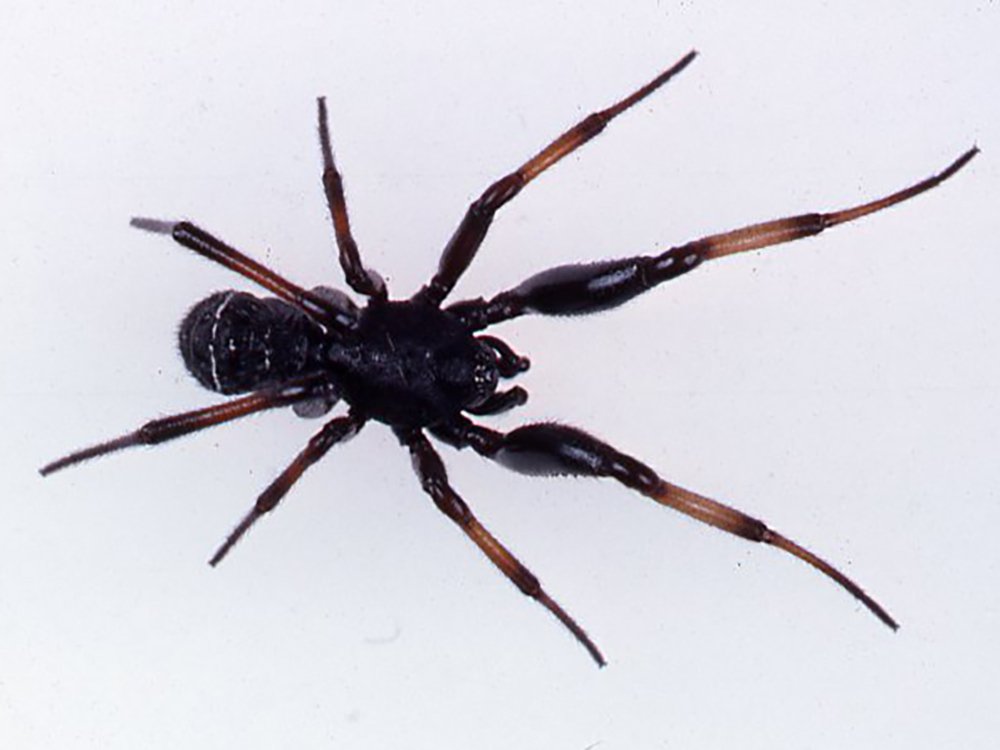Cupboard Spiders
Brown House Spider
Redback Spider
Introduction
At a casual glance the female Cupboard Spider could easily be mistaken for a Redback Spider, without that distinctive red stripe on the back.
What do Cupboard Spiders look like?
Identification
Like the majority of members in the family Theridiidae, Steatoda species have shiny, slender legs, with a small cephalothorax and a larger abdomen, which is somewhat egg-shaped in Steatoda. The colour can range from a brown or reddish plum to satiny black. The abdomen often has white or beige spots, a frontal crescent, and sometimes, small red spots or a thin red line (but never a strong stripe like a Redback Spider). There is no orange/red ‘hourglass’ spot on the underside of the abdomen, which is present in a Redback Spider.
The female Cupboard Spider could easily be mistaken for a Redback Spider, but lacks the distinctive red stripe on the back. Both spiders are from the same family, Theridiidae (also known as comb-footed spiders), so they are closely related. However, the Cupboard Spider is not considered as dangerous as its Redback relative.

© Australian Museum
Where do Cupboard Spiders live?
Habitat
Steatoda spiders build a tangled-looking web with sticky lines (a gum-footed web) under rocks, timber and bark in the bush, so long as a source of prey is available. However, their common name comes from a fondness for building their snare in any dark, sheltered, undisturbed place around the house or garden - among old furniture and junk stored in sheds and garages, under garden benches, around compost bins, in upturned flower pots and the like. Sometimes, the first signs of the Cupboard Spider are the appearance of tiny white spots of spider droppings, like small splashes of paint, on the floor underneath the web.
Distribution
Spiders of the Steatoda genus are found throughout the world in temperate and tropical climates.
Two introduced species are commonly found in and around Australian houses, Steatoda capensis and S. grossa. Native species of Cupboad Spiders are rarely found indoors but sometimes turn up in gardens under upturned flower pots and similar shelters and they can be common in some bush habitats.
How do Cupboard Spiders mate?
Life history cycle
The females produce several white to cream egg sacs, suspending them within her tangled web. The female can live for about two years, whereas the male will only live for a few months.
Breeding behaviours
The male spider is small, and inhabits the outer parts of the female's web, awaiting a chance to mate. He will generally be eaten after mating has been completed.
Male Steatoda are differently shaped to females, being more elongate, often with modified head region and some species have enlarged front legs. The males of some species may be ant mimics and can be found walking amongst leaf litter by day in search of females’ webs.

CC BY-NC 4.0
Are Cupboard Spiders dangerous?
Danger to humans
Bites from Steatoda species occur infrequently. In the past they have not been considered particularly dangerous to humans, however in a few recent cases of Steatoda bites where the spider has been identified, more serious symptoms have been recorded. In two cases, Redback antivenom has been used successfully to treat these symptoms. Minor skin lesions have been occasionally associated with the bite.
First aid
No first aid is usually required. A cold pack can be applied to help reduce any pain or swelling at the site of the bite.
References
- York Main, B. 1976.Spiders. William Collins Publishers Pty Ltd, Sydney.
- Simon-Brunet, B. 1994.The Silken Web. Reed Books, NSW.
- South, M., Wirth, P. & Winkel, K.D. 1998. Redback Spider antivenom used to treat envenomation by a juvenile Steatoda spider. MJA 169: 642.
- Winkel, K.D., Harvey, M. & Wirth, P. 2000. Steatodism treated with Redback Spider antivenom. Abstracts from Joint ACITHN & ACTM 2000 Conference, 23rd - 26th JUNE 2000, Sessions 1 to 11, The University of QLD.


